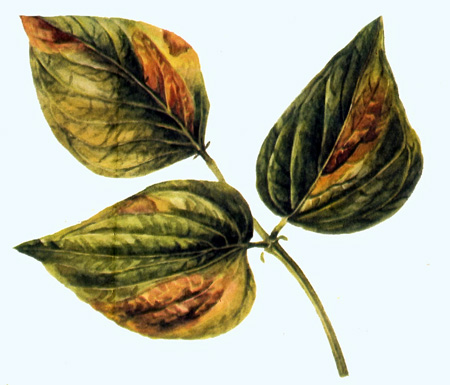Diseases
Xantomonas campestris pv. phaseoli (Smith) Dye - Common Bacterial Blight of Bean.
Systematic position.
Kingdom Procaryotae, section Gram-negative aerobic rods and cocci, family Pseudomonodaceae, genus Xanthomonas.Synonyms.
Bacillus phaseoli E.F. Smith, Pseudomonas phaseoli (E.F. Smith) E. F. Smith, Bacterium phaseoli (E.F. Smith) E. F. Smith, Phytomonas phaseoli (E. F. Smith) Bergey et al., Xanthomonas phaseoli (E. F. Smith) Dowson.Biological group.
Hemibiotroph.Morphology and biology.
Bacteriosis attacks all elevated plant parts, especially leaves. An attribute of primary phase of this bacteriosis is the appearance of small round, light-yellow spots on leaves. Later the spots increase in size and become light-brown. Infected leaf parts wrinkle and drop out. Gradually the leaf turns yellow, dies off, and often falls down. Leaves can fall down in such quantities that it resembles an autumn leaf fall. Pathogen also causes twisting and curvature of leaf ribs. On stems, the disease causes appearance of oblong brown spots with light-brown shade. Bacteriosis of stem is the most dangerous in a stage of seedlings. In this case, caulicle is affected. Fine expanding dark-green spots form on diseased beans. Light-brown and brown spots of various shape and size are observed on seeds. At early lesion, the diseased grain becomes underdeveloped, wrinkled, and puny. However, a part of the infected seeds may keep a healthy appearance. Cells of X. campestris pv. phaseoli are straight bacilli, usually 0.3-0.6 x 1.9-3.0 mkm, moving by means of polar flagella. Gram-negative. Aerob. Having capsule. On firm nutrient mediums, convex colonies (with smooth border and cream-gray color) appear in 3-7, or up to 10 days. Later they get yellow painting with a greenish shade. Diluting gelatin slowly. Hydrolyzing starch. Not forming indole. Producing H2S. Peptonizing milk. Producing alkali in litmus milk. Not restoring nitrates. Catalase reaction is positive. Optimum temperature for growth is 25-28°C. They are rather steady to the increased temperature; critical temperature for the bacteria is 48-50°C. Pathogen survives in seeds from 4-7 years, depending on the condition of their maintenance, and in vegetation residues. Insects have some significance for the bacterial infection spreading during vegetation.Distribution.
Common Bacterial Blight of Beans meets in the USA, Canada, European countries, China, Australia, Southern Africa. It is distributed in all territories of the former Soviet Union where this culture is growing; i.e., in Krasnodar and Stavropol Territories, Rostov Region, Kabardino-Balkaria, Northern Ossetia, Chechnya, the Far East, and also in Georgia, Abkhazia, Moldova, Kazakhstan, Ukraine.Ecology.
The disease develops actively at high temperature (up to 32°C) and rather low relative humidity of air. Significant development of the bacteriosis occurs during landing of seeds into the cold ground since cold weather promotes weakening of seedlings and increases their greater susceptibility.Economic significance.
The pathogen attacks plants of the family Fabaceae. This disease severity consists of destruction of seedlings and adult plants, owing to a break of the stem in places of its affection. This results in yield reduction from plants with the diseased leaves. This bacteriosis severity increases southward and is especially significant in southern regions and countries. Yield losses depend on a cultivated variety. The yield is reduced by 15-20% at moderate affection, and by 40-50% at high affection of crops. Bacteriosis is widely distributed in Kazakhstan, but being the most nocuous in conditions of Shymkent, Taraz, and especially Almaty Regions. In Moldova, the amount of diseased plants (local varieties) reaches 100%, and that of beans reaches 80-90% during vegetation. Control measures include a complex of various agronomical actions, directed toward cultivation of healthy plants. These include maintenance of crop rotation, selection of resistant varieties, correct entering of mineral fertilizers (with prevalence of potash), duly sowing, pesticide treatment of plants during vegetation, and careful removal of plant residues.Reference citations:
Balashova N.N. 1966. Bacterial blight of vegetable bean in Moldova and measures of its control. In: Bel.tyukova K.I., ed. Abstracts of reports of the All-Union symposium on bacterial diseases of plants. Kiev: Naukova Dumka, p. 50 (in Russian).Chumaevskaya M.A. 1982. Results of studying bacterioses of plants in the USSR. Biologicheskie nauki 8: 5-19 (in Russian).
Chumaevskaya M.A. & Gorodilova L.M. 1974. Bacterial diseases of agricultural plants in the Tselinograd Region. In: Kandaurov V.I. ed. Selection and Planting. Scientific technical bulletin. Shortandy: VNIIZH, p. 86-92 (in Russian).
Gerasimov B.A. & Osnitskaya E.A. 1961. Pests and diseases of vegetables. Moscow: Selkhozgiz. 536 p. (in Russian).
Gorlenko, M.V. 1947. A survey of geographical distribution of bacterial plant diseases in the USSR. Byulleten. obshchestva ispytatelei prirody, otdelenie biologii 32 (2): 61-70 (in Russian).
Gorlenko M.V. 1949. Results of studying bacterial diseases in the USSR for 30 years (1917-1947). Mikrobiologiya 18 (1): 71-81 (in Russian).
Gorlenko M.V. 1966. Bacterial diseases of plants. Moscow: Vysshaya shkola, 291 p. (in Russian).
Izrail.skii V.P. 1960. Bacterioses of leguminous plants. In: Izrail.skii V.P., ed. Bacterioses of plants. Moscow: Gosudarstvennoe izdatelstvo selskokhozyaistvennoi literatury, p.221-227 (in Russian).
Kazenas L.D. 1965. Diseases of agricultural plants of Kazakhstan. In: Jundin I.A., ed. Alma-Ata: Kainar, p. 227-228 (in Russian).
Kunichenko N.A. 1985. Bacterioses of vegetable cultures in Moldova. In: Gvozdyak R.I., ed. Bacterial diseases of plants (Abstracts of reports). Part 2. Kiev: Naukova Dumka, p. 67-68 (in Russian).
Pavlyushin V.A., ed. 2006. Bacterioses of leguminous cultures and a measure of struggle against them (Methodical recommendations). St. Petersburg: VIZR, 41 p. (in Russian)..
Shpaar D, Kleinkhempel G, Myuller G. & Naumann K. 1980. Bacterioses of cultural plants. Handbook. Moscow: Kolos, 143 p. (in Russian).
Shpiler L.H. 1966. Bacteriosis of string bean in Moldova. In: Bel.tyukova, K.I., ed. Abstracts of reports of the All-Union symposium on bacterial diseases of plants. Kiev: Naukova dumka, p. 51 (in Russian).
Shpiler L.H. 1975. Characteristic of field resistance of species of string bean to brown bacteriosis. In: Zatula D.G. et al., eds. Phytopathogenic bacteria (Abstracts of reports). Kiev: Naukova dumka, p. 165-167 (in Russian).


